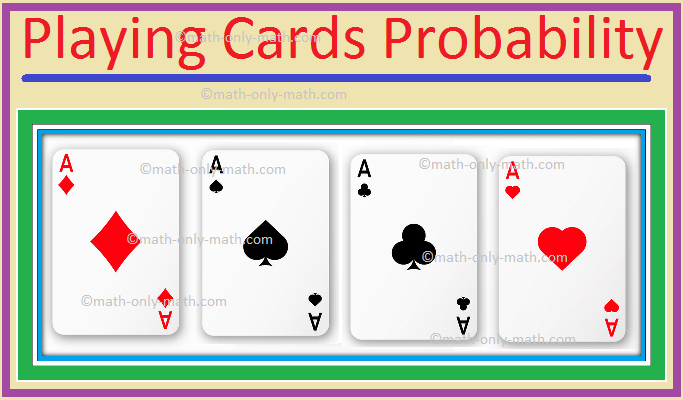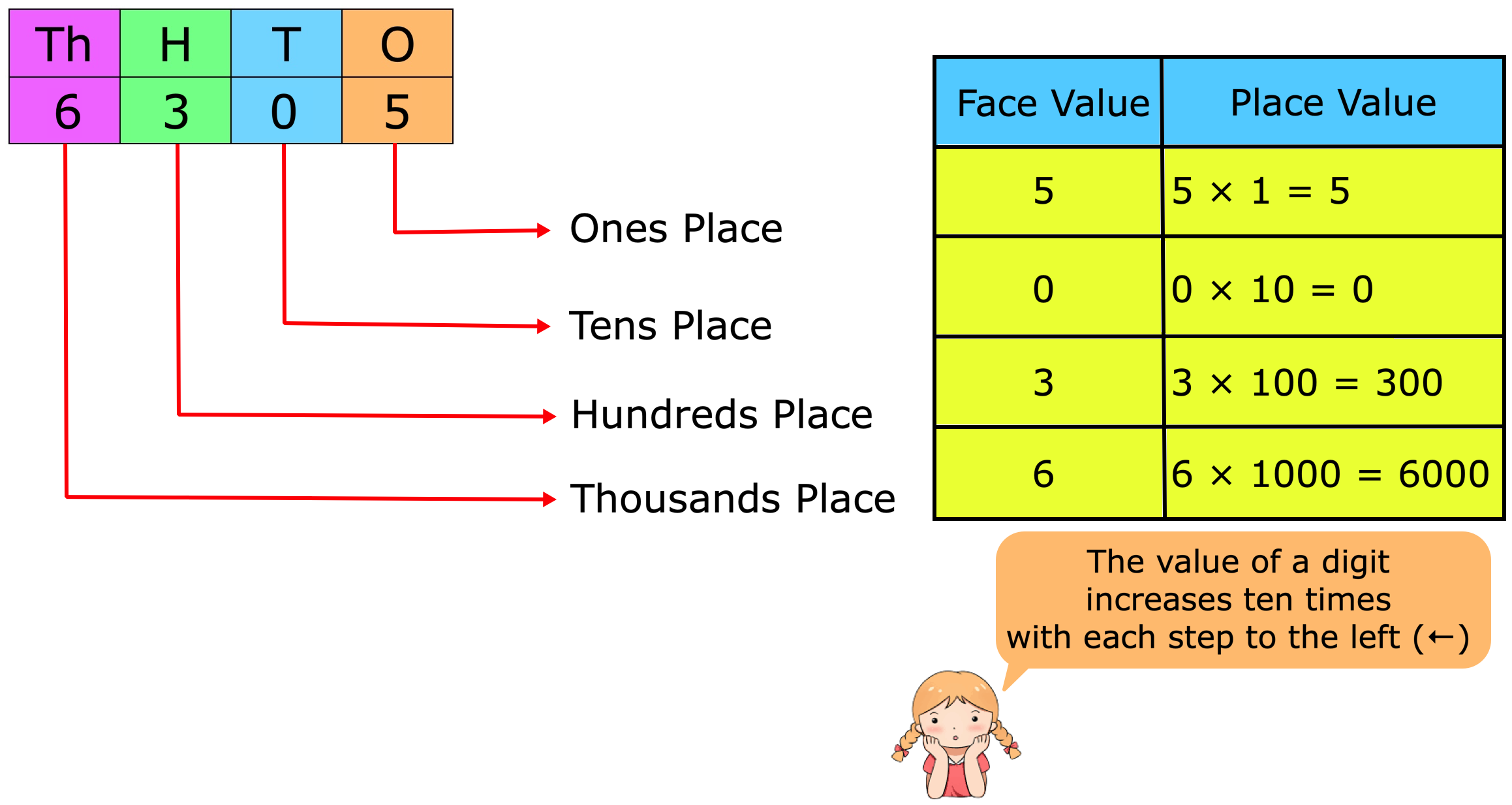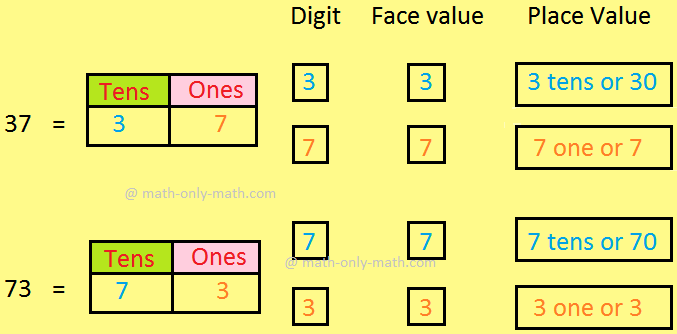Playing Cards Probability
Playing cards probability problems based on a well-shuffled deck of 52 cards.
Basic concept on drawing a card:
In a pack or deck of 52 playing cards, they are divided into 4 suits of 13 cards each i.e. spades ♠ hearts ♥, diamonds ♦, clubs ♣.
Cards of Spades and clubs are black cards.
Cards of hearts and diamonds are red cards.
The card in each suit, are ace, king, queen, jack or knaves, 10, 9, 8, 7, 6, 5, 4, 3 and 2.
King, Queen and Jack (or Knaves) are face cards. So, there are 12 face cards in the deck of 52 playing cards.
Worked-out problems on Playing cards probability:
1. A card is drawn from a well shuffled pack of 52 cards. Find the probability of:
(i) ‘2’ of spades
(ii) a jack
(iii) a king of red colour
(iv) a card of diamond
(v) a king or a queen
(vi) a non-face card
(vii) a black face card
(viii) a black card
(ix) a non-ace
(x) non-face card of black colour
(xi) neither a spade nor a jack
(xii) neither a heart nor a red king
Solution:
In a playing card there are 52 cards.
Therefore the total number of possible outcomes = 52
(i) ‘2’ of spades:
Number of favourable outcomes i.e. ‘2’ of spades is 1 out of 52 cards.
Therefore, probability of getting ‘2’ of spade
Number of favorable outcomesP(A) = Total number of possible outcome
= 1/52
(ii) a jack
Number of favourable outcomes i.e. ‘a jack’ is 4 out of 52 cards.
Therefore, probability of getting ‘a jack’
Number of favorable outcomesP(B) = Total number of possible outcome
= 4/52
= 1/13
(iii) a king of red colour
Number of favourable outcomes i.e. ‘a king of red colour’ is 2 out of 52 cards.
Therefore, probability of getting ‘a king of red colour’
Number of favorable outcomesP(C) = Total number of possible outcome
= 2/52
= 1/26
(iv) a card of diamond
Number of favourable outcomes i.e. ‘a card of diamond’ is 13 out of 52 cards.
Therefore, probability of getting ‘a card of diamond’
Number of favorable outcomesP(D) = Total number of possible outcome
= 13/52
= 1/4
(v) a king or a queen
Total number of king is 4 out of 52 cards.
Total number of queen is 4 out of 52 cards
Number of favourable outcomes i.e. ‘a king or a queen’ is 4 + 4 = 8 out of 52 cards.
Therefore, probability of getting ‘a king or a queen’
Number of favorable outcomesP(E) = Total number of possible outcome
= 8/52
= 2/13
(vi) a non-face card
Total number of face card out of 52 cards = 3 times 4 = 12
Total number of non-face card out of 52 cards = 52 - 12 = 40
Therefore, probability of getting ‘a non-face card’
Number of favorable outcomesP(F) = Total number of possible outcome
= 40/52
= 10/13
(vii) a black face card:
Cards of Spades and Clubs are black cards.
Number of face card in spades (king, queen and jack or knaves) = 3
Number of face card in clubs (king, queen and jack or knaves) = 3
Therefore, total number of black face card out of 52 cards = 3 + 3 = 6
Therefore, probability of getting ‘a black face card’
Number of favorable outcomesP(G) = Total number of possible outcome
= 6/52
= 3/26
(viii) a black card:
Cards of spades and clubs are black cards.
Number of spades = 13
Number of clubs = 13
Therefore, total number of black card out of 52 cards = 13 + 13 = 26
Therefore, probability of getting ‘a black card’
Number of favorable outcomesP(H) = Total number of possible outcome
= 26/52
= 1/2
(ix) a non-ace:
Number of ace cards in each of four suits namely spades, hearts, diamonds and clubs = 1
Therefore, total number of ace cards out of 52 cards = 4
Thus, total number of non-ace cards out of 52 cards = 52 - 4
= 48
Therefore, probability of getting ‘a non-ace’
Number of favorable outcomesP(I) = Total number of possible outcome
= 48/52
= 12/13
(x) non-face card of black colour:
Cards of spades and clubs are black cards.
Number of spades = 13
Number of clubs = 13
Therefore, total number of black card out of 52 cards = 13 + 13 = 26
Number of face cards in each suits namely spades and clubs = 3 + 3 = 6
Therefore, total number of non-face card of black colour out of 52 cards = 26 - 6 = 20
Therefore, probability of getting ‘non-face card of black colour’
Number of favorable outcomesP(J) = Total number of possible outcome
= 20/52
= 5/13
(xi) neither a spade nor a jack
Number of spades = 13
Total number of non-spades out of 52 cards = 52 - 13 = 39
Number of jack out of 52 cards = 4
Number of jack in each of three suits namely hearts, diamonds and clubs = 3
[Since, 1 jack is already included in the 13 spades so, here we will take number of jacks is 3]
Neither a spade nor a jack = 39 - 3 = 36
Therefore, probability of getting ‘neither a spade nor a jack’
Number of favorable outcomesP(K) = Total number of possible outcome
= 36/52
= 9/13
(xii) neither a heart nor a red king
Number of hearts = 13
Total number of non-hearts out of 52 cards = 52 - 13 = 39
Therefore, spades, clubs and diamonds are the 39 cards.
Cards of hearts and diamonds are red cards.
Number of red kings in red cards = 2
Therefore, neither a heart nor a red king = 39 - 1 = 38
[Since, 1 red king is already included in the 13 hearts so, here we will take number of red kings is 1]
Therefore, probability of getting ‘neither a heart nor a red king’
Number of favorable outcomesP(L) = Total number of possible outcome
= 38/52
= 19/26
2. A card is drawn at random from a well-shuffled pack of cards numbered 1 to 20. Find the probability of
(i) getting a number less than 7
(ii) getting a number divisible by 3.
Solution:
(i) Total number of possible outcomes = 20 ( since there are cards numbered 1, 2, 3, ..., 20).
Number of favourable outcomes for the event E
= number of cards showing less than 7 = 6 (namely 1, 2, 3, 4, 5, 6).
So, P(E) = Number of Favourable Outcomes for the Event ETotal Number of Possible Outcomes
= 620
= 310.
(ii) Total number of possible outcomes = 20.
Number of favourable outcomes for the event F
= number of cards showing a number divisible by 3 = 6 (namely 3, 6, 9, 12, 15, 18).
So, P(F) = Number of Favourable Outcomes for the Event FTotal Number of Possible Outcomes
= 620
= 310.
3. A card is drawn at random from a pack of 52 playing cards. Find the probability that the card drawn is
(i) a king
(ii) neither a queen nor a jack.
Solution:
Total number of possible outcomes = 52 (As there are 52 different cards).
(i) Number of favourable outcomes for the event E = number of kings in the pack = 4.
So, by definition, P(E) = 452
= 113.
(ii) Number of favourable outcomes for the event F
= number of cards which are neither a queen nor a jack
= 52 - 4 - 4, [Since there are 4 queens and 4 jacks].
= 44
Therefore, by definition, P(F) = 4452
= 1113.
These are the basic problems on probability with playing cards.
Probability
Probability of Tossing Two Coins
Probability of Tossing Three Coins
Probability for Rolling Two Dice
Probability for Rolling Three Dice
From Playing Cards Probability to HOME PAGE
Didn't find what you were looking for? Or want to know more information about Math Only Math. Use this Google Search to find what you need.
Recent Articles
-
Math Place Value | Place Value | Place Value Chart | Ones and Tens
Apr 16, 25 03:10 PM
0, 1, 2, 3, 4, 5, 6, 7, 8 and 9 are one-digit numbers. Numbers from 10 to 99 are two-digit numbers. Let us look at the digit 6 in the number 64. It is in the tens place of the number. 6 tens = 60 So… -
Place Value and Face Value | Place and Face Value of Larger Number
Apr 16, 25 02:55 PM
The place value of a digit in a number is the value it holds to be at the place in the number. We know about the place value and face value of a digit and we will learn about it in details. We know th… -
Face Value and Place Value|Difference Between Place Value & Face Value
Apr 16, 25 02:50 PM
What is the difference between face value and place value of digits? Before we proceed to face value and place value let us recall the expanded form of a number. The face value of a digit is the digit… -
Place Value and Face Value | Basic Concept on Place Value | Face Value
Apr 16, 25 02:44 PM
Learn the easiest way to understand the basic concept on place value and face value in the second grade. Suppose we write a number in figures 435 in words we write four hundred thirty five. -
Greater or Less than and Equal to | Bigger Number | Smaller Number | >
Apr 16, 25 02:31 PM
In math, greater or less than and equal to help the kids to understand how one number is different from the other number. Whether one number is bigger or smaller than the other number or both the numb






New! Comments
Have your say about what you just read! Leave me a comment in the box below. Ask a Question or Answer a Question.